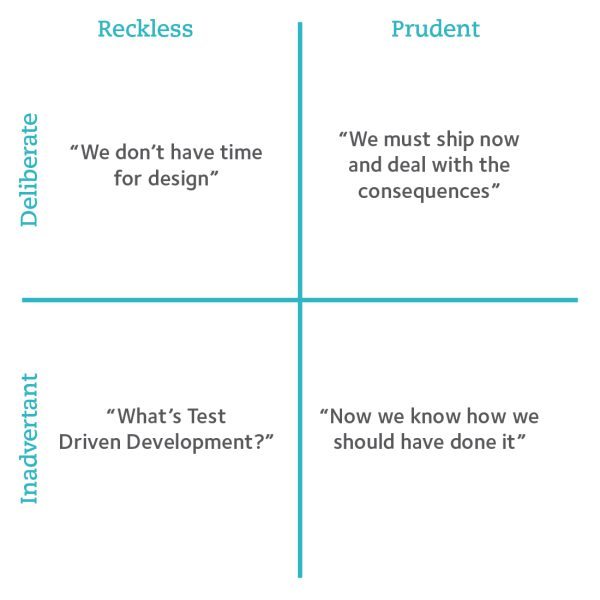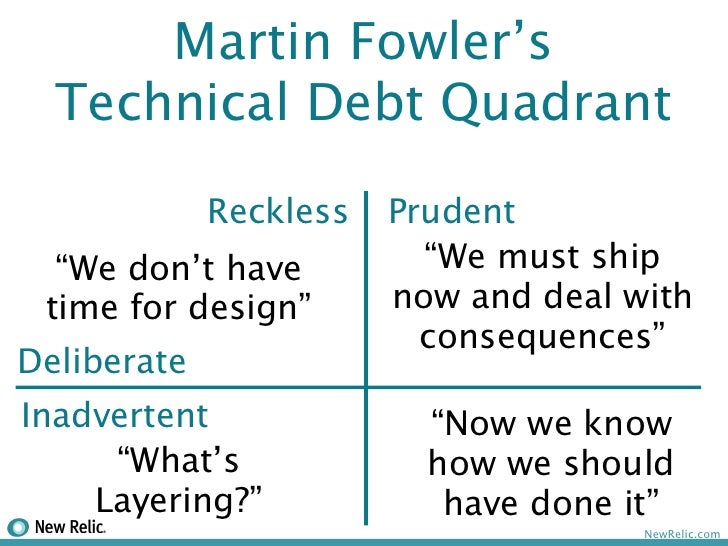10++ Fowler tech debt quadrant info
Home » techno idea » 10++ Fowler tech debt quadrant infoYour Fowler tech debt quadrant images are available in this site. Fowler tech debt quadrant are a topic that is being searched for and liked by netizens today. You can Download the Fowler tech debt quadrant files here. Get all royalty-free photos.
If you’re looking for fowler tech debt quadrant images information related to the fowler tech debt quadrant keyword, you have pay a visit to the right site. Our website always provides you with hints for viewing the highest quality video and picture content, please kindly hunt and locate more enlightening video articles and images that match your interests.
Fowler Tech Debt Quadrant. By studying the Technical Debt Quadrants you can learn about the choices made in the case of design flaws. Martin Fowler proposes the technical debt quadrant which categorises both the deliberate and inadvertent acquisition of technical debt as reckless or prudent according to the justification for accumulating it Fowler 2013. Instead of just having a debt wall onto which everybody pins things theyd like to fix you split your debt. Instead of trying to dig out an answer to technical questions about design flaws like is this considered technical debt or not Fowler wanted to know if the debt.
 Technical Debt A Catchall Phrase By Leena Continuous Delivery Medium From medium.com
Technical Debt A Catchall Phrase By Leena Continuous Delivery Medium From medium.com
In the decades since Cunningham coined the term the meaning of technical debt has evolved. Technical Debt should be reserved for cases when people have made a considered decision to adopt a design strategy that isnt sustainable in the longer term but yields a short term benefit such as making a release. Created by Martin Fowler a software development specialist it becomes a popular idea of classifying technical debt into four categories based on intent and its context. Technical Debt Over Time In the article I mentioned above Fowler writes about technical debt that comes from learning over time. That obligation is Cunninghams conception of the assets technical debt. The first stage was a debt quadrant an idea that was introduced to me by a ThoughtWorks colleague last year.
In the decades since Cunningham coined the term the meaning of technical debt has evolved.
In the decades since Cunningham coined the term the meaning of technical debt has evolved. In 2009 Fowler nuanced the twofold separation of intentional and unintentional technical debt popularized by Steve McConnel. In the decades since Cunningham coined the term the meaning of technical debt has evolved. The lower left quadrant. Fowlers quadrant takes into account two key factors that could help teams understand if they are taking on technical debt for. Fowlers Technical Debt Quadrant Giving the co-ordinates where Agile is contraindicated.
 Source: praxent.com
Source: praxent.com
Instead of just having a debt wall onto which everybody pins things theyd like to fix you split your debt. In the decades since Cunningham coined the term the meaning of technical debt has evolved. It takes a simple approach to interrogate the complex matter of technical debt. In the decades since Cunningham coined the term the meaning of technical debt has evolved. By studying the Technical Debt Quadrants you can learn about the choices made in the case of design flaws.
 Source: devopedia.org
Source: devopedia.org
The inadvertent and deliberate distinctions are. For example Martin Fowler also has a technical debt quadrant splitting up along the axes of prudent vs reckless and deliberate vs inadvertent. Instead of just having a debt wall onto which everybody pins things theyd like to fix you split your debt. It now includes much more than Cunninghams original concept. This post succinctly sums up the difference between those who produce poor designs in ways that are contrary to their best interests and those who do so knowingly and reluctantly.
 Source: link.springer.com
Source: link.springer.com
It takes a simple approach to interrogate the complex matter of technical debt. Fowlers technical debt quadrant. The lower left quadrant. Martin Fowler proposes the technical debt quadrant which categorises both the deliberate and inadvertent acquisition of technical debt as reckless or prudent according to the justification for accumulating it Fowler 2013. What is Martin Fowlers Technical Debt Quadrant.
 Source: researchgate.net
Source: researchgate.net
Technical Debt should be reserved for cases when people have made a considered decision to adopt a design strategy that isnt sustainable in the longer term but yields a short term benefit such as making a release. Lets have a look what Martin Fowler has to say about it. He felt that people used the debt metaphor to ask the wrong questions. In the decades since Cunningham coined the term the meaning of technical debt has evolved. It now includes much more than Cunninghams original concept.
 Source: researchgate.net
Source: researchgate.net
The extra effort that it takes to add new features is the interest paid on the debt. Fowlers technical debt quadrant. Lets have a look what Martin Fowler has to say about it. Instead of trying to dig out an answer to technical questions about design flaws like is this considered technical debt or not Fowler wanted to know if the debt. Martin Fowler proposes the technical debt quadrant which categorises both the deliberate and inadvertent acquisition of technical debt as reckless or prudent according to the justification for accumulating it Fowler 2013.
 Source: samuelmullen.com
Source: samuelmullen.com
Martin Fowlers Technical Debt Quadrant With this quadrant in mind technical debt is. Fowlers quadrant takes into account two key factors that could help teams understand if they are taking on technical debt for. Fowlers technical debt quadrant. This can happen for example if the interests are sufficiently small that they are not worth paying or the payoff for an earlier release is greater than the costs of the technical debt. He felt that people used the debt metaphor to ask the wrong questions.
 Source: stepsize.com
Source: stepsize.com
The extra effort that it takes to add new features is the interest paid on the debt. The extra effort that it takes to add new features is the interest paid on the debt. Martin Fowlers Technical Debt Quadrant With this quadrant in mind technical debt is. Martin Fowler the chief scientist at ThoughtWorks built upon David Cunninghams idea and created the Technical Debt Quadrant in 2009. Instead of just having a debt wall onto which everybody pins things theyd like to fix you split your debt.
 Source: dzone.com
Source: dzone.com
For example Martin Fowler also has a technical debt quadrant splitting up along the axes of prudent vs reckless and deliberate vs inadvertent. That obligation is Cunninghams conception of the assets technical debt. The Martin Fowler technical debt quadrant described above shows four types of technical debt. The lower left quadrant. Created by Martin Fowler a software development specialist it becomes a popular idea of classifying technical debt into four categories based on intent and its context.
 Source: slideshare.net
Source: slideshare.net
In the decades since Cunningham coined the term the meaning of technical debt has evolved. Prudent and deliberate when the team knows they are piling up interests but prefer to ship and deal with the consequences later. So in advising on a way to get to the outcome reduced technical debt what we needed was a method that was easy to manage and track that encouraged people to pay down the debt. Fowlers technical debt quadrant. The first stage was a debt quadrant an idea that was introduced to me by a ThoughtWorks colleague last year.
 Source: medium.com
Source: medium.com
Instead of trying to dig out an answer to technical questions about design flaws like is this considered technical debt or not Fowler wanted to know if the debt. In the decades since Cunningham coined the term the meaning of technical debt has evolved. That obligation is Cunninghams conception of the assets technical debt. Fowlers quadrant takes into account two key factors that could help teams understand if they are taking on technical debt for. This post succinctly sums up the difference between those who produce poor designs in ways that are contrary to their best interests and those who do so knowingly and reluctantly.
 Source: researchgate.net
Source: researchgate.net
In the decades since Cunningham coined the term the meaning of technical debt has evolved. The extra effort that it takes to add new features is the interest paid on the debt. In the decades since Cunningham coined the term the meaning of technical debt has evolved. By studying the Technical Debt Quadrants you can learn about the choices made in the case of design flaws. Instead of trying to dig out an answer to technical questions about design flaws like is this considered technical debt or not Fowler wanted to know if the debt.
 Source: infinityworks.com
Source: infinityworks.com
In 2009 Fowler nuanced the twofold separation of intentional and unintentional technical debt popularized by Steve McConnel. The Martin Fowler technical debt quadrant described above shows four types of technical debt. That obligation is Cunninghams conception of the assets technical debt. Martin Fowlers Technical Debt Quadrant With this quadrant in mind technical debt is. Instead of trying to dig out an answer to technical questions about design flaws like is this considered technical debt or not Fowler wanted to know if the debt.
This site is an open community for users to share their favorite wallpapers on the internet, all images or pictures in this website are for personal wallpaper use only, it is stricly prohibited to use this wallpaper for commercial purposes, if you are the author and find this image is shared without your permission, please kindly raise a DMCA report to Us.
If you find this site helpful, please support us by sharing this posts to your preference social media accounts like Facebook, Instagram and so on or you can also bookmark this blog page with the title fowler tech debt quadrant by using Ctrl + D for devices a laptop with a Windows operating system or Command + D for laptops with an Apple operating system. If you use a smartphone, you can also use the drawer menu of the browser you are using. Whether it’s a Windows, Mac, iOS or Android operating system, you will still be able to bookmark this website.